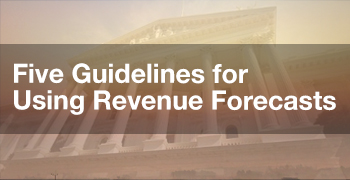
Monthly Jobs Report (Delayed) December 11, 2025
California's delayed traditional jobs report suggests the state lost 6k jobs in September, and the August report was revised down from +4k to -10k jobs. September marks the fourth consecutive month of net job decline for the traditional report. Employment numbers from a secondary source, a household survey, have also deteriorated over the past four months - with the unemployment rate climbing to 5.6 percent and more than 1.1 million workers now out of work.
Income Tax Withholding Tracker December 5, 2025
Income tax withholding in November came in $415 million (6 percent) above budget projections and 3 percent higher than last year. Withholding since mid-October has grown slower (4 percent) compared to the strong summer months that averaged more than 10 percent year-over-year growth. For the fiscal year to-date, income tax withholding remains 7 percent higher than the budget act projections and 9 percent higher than the prior year.
2025 Update: Tech Company Stock Pay Accounts for One-Quarter of Withholding Growth So Far in 2025-26 December 3, 2025
California's technology companies, including Apple, Google, Nvidia, Meta, and Broadcom are the most valuable companies in the world and employ thousands of highly-paid workers in the state. Many employees at these companies receive equity pay, such as stock options and restricted stock units, in addition to their base salary. As we first pointed out two years ago, state income tax withholding on stock pay has grown to more than $10 billion annually due to the AI boom in asset prices for these companies. With updated data through 2025Q3, we now believe growing withholding from these sources accounted for a quarter of the strong income tax withholding growth seen in the first three months of 2025-26.
California New Car Registrations: October 2025 December 3, 2025
Registrations Dropped in October. Seasonally adjusted new car registrations declined by 2.4 percent in October. October registrations were 5 percent lower than recent peaks in December and April but slightly higher than the average level over the last couple of years.
Cannabis Tax Revenue Update (2025 Q3) December 2, 2025
The administration currently estimates that retail excise tax revenue was $177 million in the third quarter of calendar year 2025 (July through September). This is the highest quarterly total since the state eliminated the cultivation tax. With this latest data, we currently project cannabis tax revenues of $631 million in 2025-26, nearly $100 million below the budget assumption for 2025-26.
Firearms and Ammunition Revenue Update (2025 Q3) November 18, 2025
Beginning July 2024, Chapter 231 of 2023 (AB 28, Gabriel) imposed an 11 percent excise tax on retail sales of firearms, firearm precursor parts, and ammunition, with some exemptions. Current tax return data suggest that the revenues from this tax will total around $58 million for 2024-25. Further, tax returns filed for the third quarter of 2025 show total tax due of $13 million—slightly below the quarterly average in the first year of the program.
California New Car Registrations: September 2025 November 14, 2025
Registrations Flat in September. Following three straight months of substantial growth, seasonally adjusted new car registrations grew just 0.1 percent in September. This is 3 percent lower than recent peaks in December and April but somewhat higher than the average level over the last couple of years.
California Housing Affordability Tracker (3rd Quarter 2025) November 6, 2025
Our post provides an updated snapshot of housing affordability in California. Over the last few years, we have seen a rapid increase in California housing costs, led by the dramatic increase in the costs of purchasing a home. Despite no significant growth in housing prices since 2024, monthly costs for a newly purchased home are about $2,400 higher than they were just a few years ago. This increase is driven both by increases in home prices between 2020 and 2022 and an increase in mortgage rates since 2022.
The rapid increase in mortgage rates in 2022 has also left most existing homeowners "locked-in" to mortgages with rates significantly lower than currently available. Almost 80 percent of California homeowners have mortgage rates under 5 percent, compared to current rates of about 6.25 percent. These homeowners face a significant additional financial cost to moving, further limiting the number of homes available for sale.
Inflation Tracker November 5, 2025
October data for the US show annual inflation remained above pre-pandemic averages with the downward trend seen since mid-2022 stalling. Between August 2024 and August 2025, prices for US consumers grew by 2.9% and prices for CA consumers grew by 3.3%. The growth in overall prices since mid-2025 has included a modest increase in the prices for consumer goods in addition to rising prices for services. Consumer expectations about inflation in the next one to five years remain elevated above pre-2025 levels.
California New Car Registrations: August 2025 October 7, 2025
Third Straight Month of Growth. Seasonally-adjusted new car registrations grew 1.6 percent in June, 1 percent in July, and 5 percent in August, but they remain 3 percent lower than recent peaks in December and April. Sales are now somewhat higher than the average level over the last couple of years.
California Labor Market Showing Broad Signs of Weakness September 30, 2025
The state's topline jobs report paints a worrisome picture about the labor market: businesses have shed 20,000 jobs so far this year and more workers report being unemployed. This post brings in new data, including a rise in layoffs and the number of long-term unemployed workers, moderating recent wage growth, and a hiring slowdown in one key growth sector (government jobs), that show broader signs of softness and raise the possibility that the labor market has weakened further in the past few months.
Cannabis Tax Revenue Update (2025 Q2) September 15, 2025
For cannabis excise tax returns filed for the second quarter of 2025, the total amount of tax due is $147 million. With this latest data, we currently project cannabis tax revenues of $603 million in 2024-25 and $773 million in 2025-26.
California New Car Registrations: July 2025 September 9, 2025
Seasonally adjusted new car registrations grew 1.5 percent in June and 1 percent in July but remain 8 percent lower than three months prior. This moderate growth stands in contrast to the substantial volatility we had observed in the prior six months. Sales remained slightly lower than the average level over the last couple of years.
Updated "Big Three" Revenue Outlook August 21, 2025
Revenues Presently on a Path to Beat Budget Expectations. Our updated forecast anticipates revenues from the state’s three largest taxes (income, corporation, and sales) will come in above the level assumed in the recently adopted state budget. This upgraded outlook is entirely attributable to higher expectations for income tax collections. Income tax collections are being driven higher by enthusiasm around artificial intelligence, which has pushed the stock market to record highs and boosted compensation among the state’s tech works. Given this, we suggest approaching the improved revenue outlook with guarded optimism. Further, the state was expected to enter the next budget cycle with a sizable operating deficit. This fact, combined with the state's complicated Constitutional budget rules, means revenue improvements are likely to translate to smaller deficits, rather than new budget capacity.
Firearms and Ammunition Revenue Update (2025 Q2) August 18, 2025
Beginning July 2024, Chapter 231 of 2023 (AB 28, Gabriel) imposed an 11 percent excise tax on retail sales of firearms, firearm precursor parts, and ammunition, with some exemptions. For firearm and ammunition excise tax returns filed for 2024-25, the total amount of tax due is $58 million—a bit lower than the budget package revenue assumption.
















